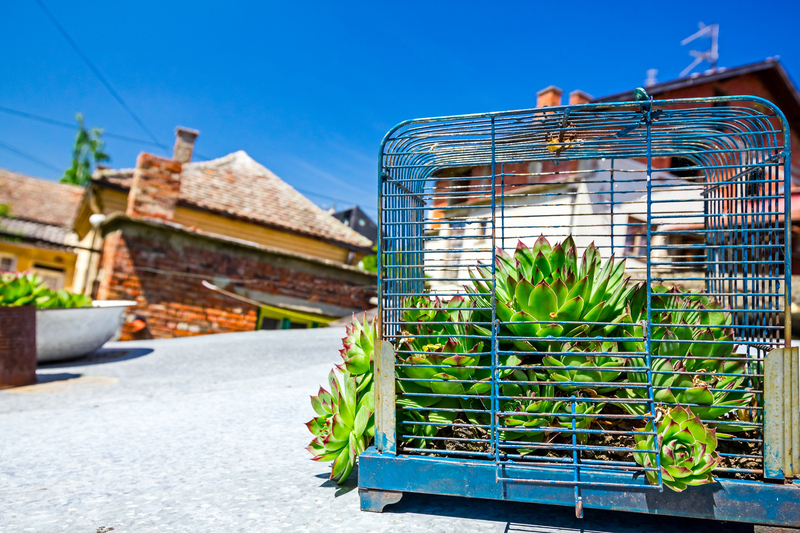Gardening's Quiet Revolution Against Climate Change
Posted on 30/06/2025
Gardening's Quiet Revolution Against Climate Change
Climate change stands as one of the most pressing challenges of our era. As weather patterns shift, temperatures rise, and biodiversity falters, the world seeks answers. Among grand governmental plans, technological innovations, and international meetings, quietly grows a revolution that each person can join: gardening. In recent years, keen observers and environmentalists have recognized gardening's subtle but profound role in the battle against climate change.
The Role of Gardening in Environmental Change
While global strategies to reduce carbon emissions often take center stage, the local impact of everyday activities is astonishingly powerful. Through sustainable gardening practices, individuals can meaningfully impact carbon capture, ecosystem restoration, and local climate resilience. Here's why gardening's quiet revolution against climate change should not be underestimated:
- Sequestration of Carbon: Plants, through photosynthesis, absorb carbon dioxide and release oxygen. Even a small garden can sequester significant amounts of carbon annually.
- Improved Biodiversity: Gardens provide habitats for bees, butterflies, birds, and beneficial insects, supporting local wildlife.
- Reduction of Urban Heat: Plants cool the air, reducing the urban heat island effect that plagues many cities.
- Stormwater Management: Gardens absorb rainwater, decreasing flood risk and soil erosion.
- Reduction of Food Miles: Growing food at home cuts the need for long-distance transportation, lowering carbon footprints.
The Science Behind Plants' Climate Impact
It's easy to underestimate the power of a single flower or shrub. Yet, the cumulative effect of millions of gardens is spectacular:
- Carbon Sink Effect: Healthy soil and plant roots lock away carbon for years, making gardens miniature carbon sinks.
- Albedo Effect: Plant coverage reflects sunlight and reduces ground-level heat absorption, resulting in natural local cooling.
- Soil Health: Diverse plantings and organic matter encourage soil organisms that improve nutrient cycling and carbon storage.

Gardening Techniques for a Climate-Resilient Future
How can the average gardener join this quiet revolution against climate change? The answer lies in climate-smart gardening techniques and making simple, informed choices in the backyard.
1. Emphasize Native and Drought-Resistant Plants
- Native species are adapted to local climate, pests, and soil. They require less water, fewer pesticides, and less fertilizer, thus lowering environmental impact.
- Drought-resistant plantings ensure green spaces stay functional and beautiful, even in hotter and drier conditions.
Example: In drought-prone California, succulent-focused gardens flourish with minimal irrigation--a direct response to water scarcity and climate stress.
2. Practice No-Dig Gardening and Mulching
- No-dig gardening disrupts soil structure less, preserving carbon and crucial soil life that aids in decomposition and nutrient cycling.
- Mulch (such as wood chips or straw) minimizes soil moisture loss, suppresses weeds, and eventually decomposes into organic matter, boosting soil's carbon storage.
3. Composting: Turning Waste into Resource
- By composting organic kitchen and garden waste, you reduce landfill methane emissions and return valuable nutrients to your garden soil.
- Rich, composted soils store more carbon--they are spongy, alive, and resilient against erosion and extreme weather.
4. Encourage Biodiversity and Wildlife Corridors
- Planting a diverse array of species creates sanctuary for pollinators, birds, and beneficial insects.
- Mini-wildlife corridors, made from Yarrow, Milkweed, or native grasses, support animal movement and genetic diversity--even in urban settings.
5. Harvest Rainwater and Reuse Greywater
- Installing rain barrels and ponds reduces tap water dependency and helps manage stormwater, protecting water tables during droughts.
- Greywater from sinks or baths (using eco-friendly soaps) can hydrate non-edible areas, further easing demand on precious water resources.
The Community Impact of Climate-Conscious Gardening
One garden can start a movement. A block filled with home gardens can transform an urban heat island into a green, resilient community oasis. Here's how:
- Community Gardens: These shared spaces produce local food, foster outdoor learning, and create gathering places--improving physical and social health.
- Green Infrastructure: Strategic planting along city streets, rooftops, and public spaces helps cities adapt to climate extremes, battle air pollution, and enhance urban livability.
- Educational Outreach: School gardens and neighborhood initiatives spread climate-smart gardening techniques, amplifying collective impact.
Case in point: In London, the Capital Growth initiative supports thousands of community gardens, contributing to lower carbon emissions, fresher air, and improved food security throughout the city.
Victory Gardens Reimagined for Today
During World War II, "Victory Gardens" were promoted as patriotic responses to food shortages. Today's gardening revolution is about ecological victory--addressing the climate crisis with every tomato staked and wildflower sown.
Modern climate gardens are refuges for biodiversity, carbon sponges, and climate action powerhouses, all rolled into one.
Sustainable Gardening Supplies and Practices
To maximize gardening's climate impact, even your choice of tools and materials matters. Here are essential tips for a low-carbon gardening toolkit:
Choose Eco-Friendly Products
- Opt for hand tools over power tools when possible, reducing fossil fuel use and emissions.
- Select peat-free compost--peat harvesting destroys valuable carbon-sequestering bogs.
- Buy from local nurseries to limit the transport footprint of plants and soil.
Reduce Chemical Use
- Use organic fertilizers and natural pest controls (like neem oil or companion planting) to protect pollinators and microbial soil life.
- Limit synthetic herbicides and pesticides, which harm more than their intended targets and can pollute waterways.
Minimize Single-Use Plastics
- Utilize biodegradable pots, upcycled containers, or recycled plastic products.
- Carefully store and reuse trellises, netting, and seed trays year after year.
Gardening as a Pathway to Climate Hope
Gardening's climate revolution is powerful not just for its tangible results, but for its ability to inspire hope. As governments, businesses, and international coalitions seek sweeping solutions, individuals--through simple, accessible acts of tending to the earth--can reclaim agency and build a sense of purpose.
Psychological studies have shown that people who garden report higher levels of well-being and resilience in the face of climate anxiety. The knowledge that one's own small plot can be part of a global solution is powerfully motivating.
Key Benefits Beyond Carbon
- Connecting with Nature: Gardening nurtures a personal appreciation for biodiversity and ecosystem health.
- Building Community: Sharing seeds, tools, produce, and advice brings people together to learn from one another and build resilience.
- Enhancing Food Security: Homegrown produce is fresh, healthy, and significantly lowers reliance on industrial agriculture.
Overcoming Barriers to Climate-Positive Gardening
Despite its many advantages, some may hesitate to join gardening's quiet revolution against climate change due to:
- Lack of space (especially in cities)
- Time constraints or physical limitations
- Uncertainty about where to start
Fortunately, modern innovations have tackled these hurdles. Vertical gardening, container planting, rooftop and balcony gardens, and community garden plots mean almost anyone can participate.
Simple Steps to Begin Climate-Smart Gardening
- Start small: Even a few pots of herbs on a windowsill can make a difference and provide fresh, low-impact food.
- Join or support a community garden: These spaces provide opportunities and resources for those lacking access to land or time.
- Learn continuously: Countless online resources, free classes, and local experts are ready to help you make environmentally sound choices.

The Future: Scaling Gardening's Climate Impact
As awareness of gardening's role in combatting climate change grows, efforts are underway to turbocharge its impact:
- Green policy initiatives encouraging urban and suburban planting
- Incentives for homeowners to convert lawns into carbon-sequestering gardens
- Large-scale regeneration projects using native planting to restore degraded land
- Promotion of edible landscapes in public and private spaces
- Integration of traditional agricultural knowledge with cutting-edge ecological science
Examples from around the world highlight what is possible. In Singapore, vertical gardens and green roofs cool the city and absorb both stormwater and pollution. In sub-Saharan Africa, agroforestry projects combine food production with reforestation, strengthening both climate resilience and livelihoods.
Conclusion: The Promise of Gardening's Quiet Revolution
Gardening's quiet revolution against climate change is proof that meaningful action does not always require vast resources or complex technologies. From city balconies to country plots, every gardener becomes part of a worldwide movement, sequestering carbon, nurturing biodiversity, and building community--one seed at a time.
As more people recognize the impact of their gardening choices, the ripple effect grows. Every compost heap, pollinator border, and rain barrel is a vote for a healthier planet and a hopeful future. The time has never been better or more urgent to pick up a trowel and dig in--with purpose. Join the revolution--your garden, just like the planet, stands to thrive.
Additional Resources
- EPA: Greenacres
- Royal Horticultural Society: Sustainability in Gardening
- National Wildlife Federation: Garden for Wildlife
- Garden Organic UK
Let gardening's gentle, persistent revolution help tip the climate scales in favor of the Earth, its people, and the generations yet to come.



